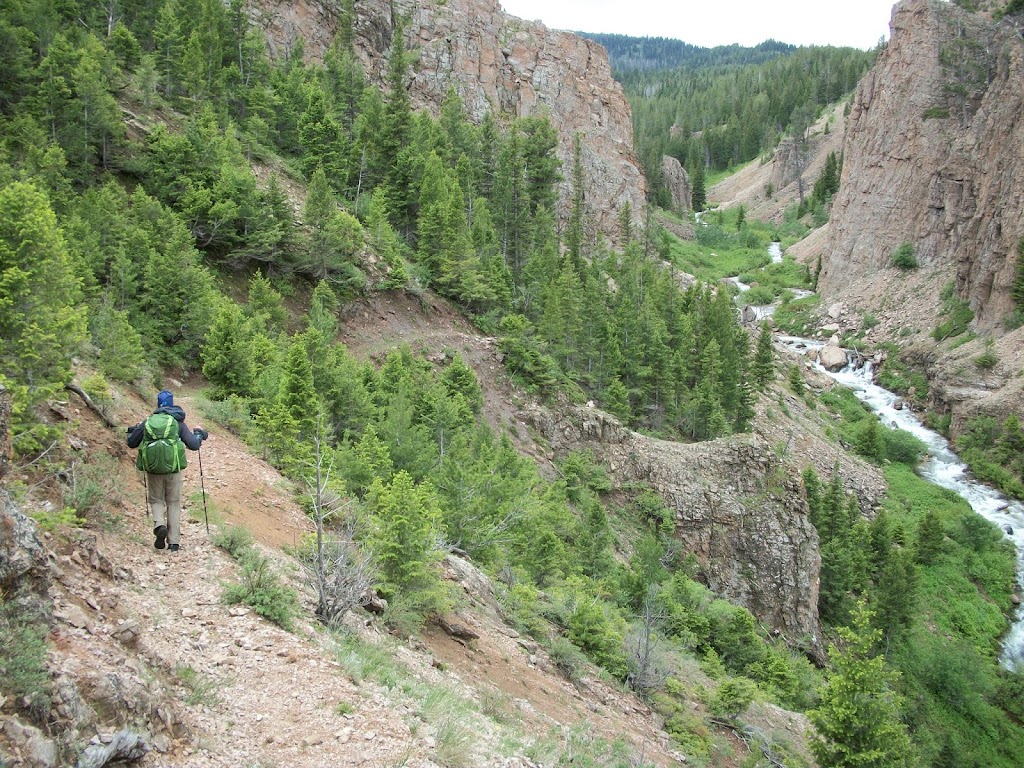
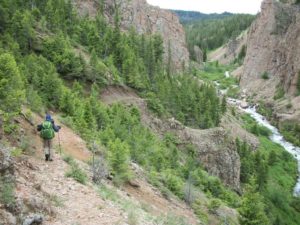 |
| Climbing up in the Centennial Mountains following Hell Roaring Creek |
Summer on the CDT Part 2: Raynolds Pass to Lima
by Tim Mosbacher
After a night’s rest in Ennis, we got up early and drove back to where we had left off and where it was raining just as hard as the day before, at Raynolds Pass. I hugged my wife goodbye, and we were off. After about fifty yards, I decided I wanted to switch out of the new shoes I had put on that morning, but upon turning around, I realized my wife was already gone. This would haunt me in the days ahead.
We struck out in the tall grass through the hills of the southern tip of the Gravelly Mountain Range. It was easy going, and after a couple of miles we hit an eight-mile road section. We loved road sections because we could make up for lost time. For me, they were great but painful because it was hard to keep up with Ken’s long stride. He was especially motivated since we were about to hike much of the length of the Centennial Mountains.
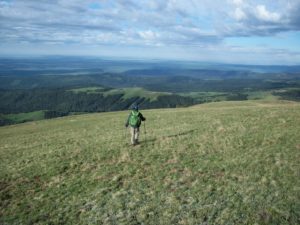 |
| Hiking in the Centennials looking South into Idaho – looking for rock cairns to tell you the way |
We crossed the eastern edge of the Centennial Valley and entered the Centennial Mountains. It was rather funny because the trail was marked by a CDT sign about every 100 meters, which had not been the norm. We soon were climbing high above the valley and had a spectacular view looking down upon the Red Rock Lakes National Wildlife Refuge.
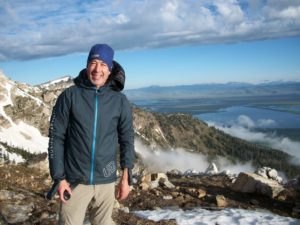 |
| Red Rock Lakes National Wildlife Refuge below the Centennial Mountains |
As the day wore on, the back of my right foot started to chafe. Nothing I could do would alleviate it (in hindsight, not sure why I did not try a runner’s knot). We gradually climbed from around 7000 to over 9000 feet. The views of northern Idaho and the Tetons were spectacular. We could see for hundreds of miles. The trail was rough with hardened vole trails everywhere, making it painful to walk. My foot started to really hurt. After 24 miles we called it a day and set up camp on the mountainside.
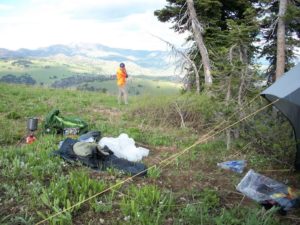 |
| Campspot and making a call home when you can |
We could tell it might rain, but did not expect the storm that hit us. Lightening was all around us and the wind was howling. Getting out of a bivy is difficult at our age, but naked and in a storm made it even crazier. We ran around in the dark trying to find rocks to weight down the stakes holding down the tarp. We were successful, but somehow during the night my sleeping bag angled out from under the tarp and by morning I was drenched. Two people under one tarp was not working out.
If you have never slept in a bivy, you need to try it. Each night one of us would say we were “getting into the cockpit,” i.e., bivy. It is like climbing into a cocoon. You cannot bend or move, and your face is about a half inch from the mosquito netting cover. Many people would be claustrophobic in one. Getting out of it, especially if you are not flexible, is an achievement. Deciding to use the restroom at night became a huge mental tug of war of whether it was worth the effort.
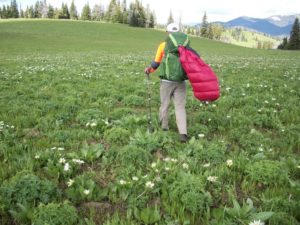 |
| Drying the sleeping bag while hiking (notice the lack of trail) |
The next morning was sunny so we hiked with our bags hanging out of our packs to dry. Once again the views were mind-blowing as we hiked along old trails and roads that had once been used for mining. We entered an old growth forest that was incredible, and then a strange occurrence happened. We saw people on the trail. We were now over 115 miles from Old Faithful and had only seen the one runner above West Yellowstone days earlier, but all of a sudden the trail had people on it. Numerous people were hiking into Aldous Lake, located on the Idaho side of the Centennial Mountains. We quickly hiked through this area and were soon faced with another concern.
About five miles after Aldous Lake we took shelter from a passing storm. When we started to hike again, there was no trail. We looked for the trail, we backtracked, Ken used his phone to try to locate us, but we could not find the trail. We had a good handle on where we thought we were, so we just started hiking through a burn area. After about an hour, we finally stumbled across the trail that a prior fire had wiped out. It cost us quite a bit of time and rattled us a bit since it was our first time getting lost. We shut her down a little early, but we had hiked 24 miles and needed a rest.
 |
| Always good to find a CDT sign, especially when you are close to a resupply |
In the morning we started fast, as later that day we were going to be resupplied in Lima by the Beckys. We had 24 miles to go by 3:00, with no water for the last 16 miles, but we ended with seven miles of road hiking. I had read from other thruhikers that the Lima bar had the best steaks that you self-grill in the middle of the bar. It was all I could think about as we plowed through the miles. It got hotter and hotter, and we had little water, but sure enough at 3:00 we got picked up at our designated spot and rode into Lima.
Resupply was always a highlight, and it was what we dreamed about the entire time hiking. In Lima, we ate one of the best meals I’ve had in my life at the Peat Steakhouse and then proceeded to sit outside and repack our packs. Our lodging was devised from a single-wide mobile home converted into two hotel rooms on the same lot as Peat’s. The next section was going to be four days, 103 miles, and would end up being one of the toughest sections.
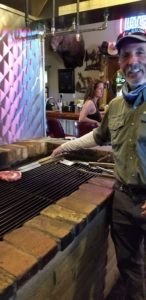
Ken Ellis cooking up a steak at the Peat Steakhouse in Lima
 missoulamarathon.org >>
missoulamarathon.org >>